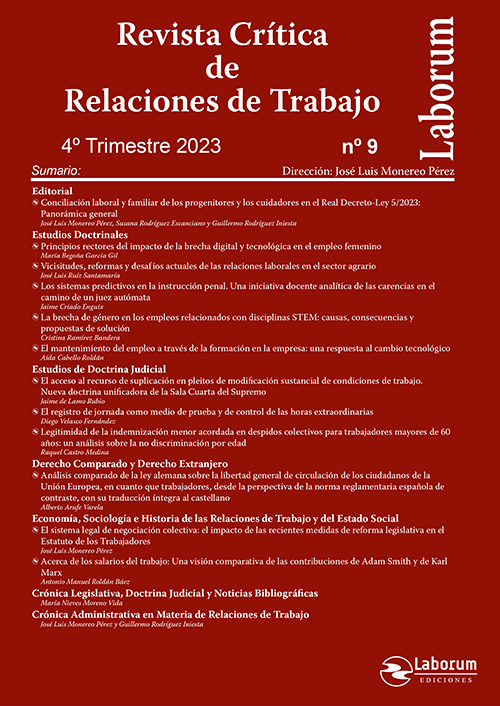The gender gap in the study of stem disciplines: causes, consequences and proposed solutions
Keywords:
STEM disciplines, stereotypes, gender gap, women underrepresentation, unconscious biasAbstract
In Spain -and in most countries around the world- it is possible to observe that the proportion of women who study STEM disciplines (science, technology, engineering and mathematics, for its acronym in English) is lower than the number of men who specialize and dedicate their professional careers to these areas. In the present study, we intend to undertake an analysis of the causes and consequences of this empirical regularity, presenting the main explanations given about the matter and discussing whether these divergent interests are the result of innate biological differences between the sexes or if, on the contrary, they are based on multiple stereotypes and unconscious gender biases that persist in our society, as indicated by the most recent lines of research in this regard. Finally, solutions will be proposed to mitigate this problem and contribute to creating a future in which women, by their dedication to the scientific, mathematical and engineering fields, can also lead the technological and digital transformation that is changing the world as we know it.
Downloads
References
Blumberg, S., Krawina, M., Mäkelä, E., y Soller, H., “Women in tech: The best bet to solve Europe’s talent shortage”, McKinsey Digital, 2023, disponible en https://www.mckinsey.com/capabilities/mckinsey-digital/our-insights/women-in-tech-the-best-bet-to-solve-europes-talent-shortage#/.
Breda, T., Jouini, E., Napp, C. y Thebault, G., “Gender stereotypes can explain the gender-equality paradox”, PNAS, vol. 117, núm. 49, 2020.
Castillo Sánchez, M. y Gamboa Araya, R., “La vinculación de la educación y género”, actualidades Investigativas en Educación, vol. 13, núm. 1, 2013.
Hill, C., Corbett, C. y Rose, A. S., Why so few? Women in Science, Technology, Engineering and Mathematics, 2010.
Hosein, A. “Girls’ video gaming behaviour and undergraduate degree selection: A secondary data análisis approach”, Computers in Human Behaviour, vol. 91, 2019.
Lavy, V. y Sand, E., “On the origins of gender gaps: short- and long-term consequences of teachers’ biases”, Journal of Public Economics, vol. 167, 2018.
Lewis, V.O., Scherl, S.A. y O’Connor, M.I., “Women in orthopaedics-way behind the number curve”, The journal of bone and joint surgery, vol 94, núm. 5, 2012.
López-Navajas, A., “Análisis de la ausencia de las mujeres en los manuales de la ESO: una genealogía de conocimiento ocultada”, Revista de Educación, núm. 363, 2014.
Mateos Sillero, S. y Gómez Hernández, C., Libro Blanco de las mujeres en el ámbito tecnológico, Madrid: Secretaría de Estado para el Avance Digital, Ministerio de Economía y Empresa., 2019, disponible en https://spainaudiovisualhub.mineco.gob.es/content/dam/seteleco-hub-audiovisual/resources/pdf/LibroBlancoFINAL.pdf.
Morales Inga, S y Morales Tristán, O., “¿Por qué hay pocas mujeres científicas? Una revisión de literatura sobre la brecha de género en carreras STEM”, Revista internacional de investigación en comunicación, vol. 22, núm. 22, 2020.
Nass, C., Moon, Y., y Green, N. “Are computers gender-neutral? Gender stereotypic responses to computers”, Journal of Applied Social Psychology, vol. 27, núm. 10, 1997, disponible en https://citeseerx.ist.psu.edu/viewdoc/download?doi=10.1.1.536.7047&rep=rep1&type=pdf.
Richardson, S.S., Reiches, M.W., Bruch, J., Boulicault, M., Noll, N.E. y Shattuck-Heidorn, H., “Is there a Gender-Equality Paradox in Science, Technology, Engineering, and Math (STEM)? Commentary on the Study by Stoet and Geary”, Psychological Science, vol. 31, núm. 3, 2018.
Sáinz Ibáñez, M., Brechas y sesgos de género en la elección de estudios STEM ¿Por qué ocurren y cómo actuar para eliminarlas?, Sevilla: Centro de Estudios Andaluces, 2020, disponible en https://www.centrodeestudiosandaluces.es/publicaciones/n-84-brechas-y-sesgos-de-genero-en-la-eleccion-de-estudios-stem-por-que-ocurren-y-como-actuar-para-eliminarlas.
Sorby, S.A. y Baartsmans, B.J., “The development and assessment of a course for enhancing the 3-D spatial visualization skills of first year engineering students”, Journal of Engineering Education, vol. 89, núm. 3, 2000.
Spencer, S.J., Logel, C. y Davies, P.G., “Stereotype Threat”, Annual Review of Psychology, vol. 67, 2016, disponible en https://www.annualreviews.org/doi/10.1146/annurev-psych-073115-103235#.
Spencer, S.J., Steele, C.M. y Quinn, D.M., “Stereotype threat and women’s math performance”, Journal of Experimental Social Psychology, vol. 35, núm. 4, 1999.
Usart, M., Sánchez-Canut, S. y Lores, B., “El ámbito de las STEM no atrae el talento femenino”, Observatorio social de la Fundación “La Caixa”, 2022, disponible en https://elobservatoriosocial.fundacionlacaixa.org/-/el-ambito-de-las-stem-no-atrae-el-talento-femenino.
VV.AA. “Genome-wide analyses of self-reported empathy: correlations with autism, schizophrenia, and anorexia nervosa”. Translational Psychiatry, vol. 8, núm. 35, 2018. https://doi.org/10.1038/s41398-017-0082-6.
OTRAS REFERENCIAS
Accenture, Accenture Finds Girls’ Take-up of STEM Subjects is Held Back by Stereotypes, Negative Perceptions and Poor Understanding of Carreer Options, 2017.
Asociación Española para la Digitalización, Radiografía de las vacantes en el sector tecnológico, 2022, disponible en https://www.digitales.es/wp-content/uploads/2022/06/informeEmpleo2022_280622.pdf.
Comisión Europea, Employment and social development in Europe: addressing labour shortages and skill gaps in the EU”, 2023, disponible en https://ec.europa.eu/commission/presscorner/detail/en/ip_23_3704.
Comisión Europea, Women in the digital age. Executive summary, 2018, disponible en https://op.europa.eu/es/publication-detail/-/publication/84bd6dea-2351-11e8-ac73-01aa75ed71a1.
EUROSTAT, Gender pay gap in unadjusted form, disponible en https://ec.europa.eu/eurostat/databrowser/view/tesem180/default/table?lang=en.
Instituto de las Mujeres, Alumnado matriculado en enseñanzas universitarias de Grado según ámbito de estudio, disponible en https://www.inmujeres.gob.es/MujerCifras/Educacion/AlumnadoUniversitario.htm.
Instituto Nacional de Estadística, Número de trabajadores a tiempo parcial en el empleo total según periodo, 2022, disponible en https://www.ine.es/jaxiT3/Tabla.htm?t=10893&L=0.
Instituto Nacional de la Seguridad Social, Pensiones contributivas del Sistema de la Seguridad Social en vigor a 1 de agosto de 2023, disponible en https://www.seg-social.es/wps/portal/wss/internet/EstadisticasPresupuestosEstudios/Estadisticas/EST23/2575/c0e31961-9a30-4579-9ff7-f522986d9b3e/25dca321-7c3c-468b-966d-eae8bdaf6f48/949d0956-2baa-4c30-ac64-2d1e752a0b40.
Mckinsey Global Institute, The future of work in Europe, 2020, disponible en https://www.mckinsey.com/~/media/mckinsey/featured%20insights/future%20of%20organizations/the%20future%20of%20work%20in%20europe/mgi-the-future-of-work-in-europe-discussion-paper.pdf.
Ministerio de Ciencia, Innovación y Universidades, Inserción laboral de lo
s egresados universitarios. Curso 2013-2014 (análisis hasta 2018), disponible en https://www.universidades.gob.es/wp-content/uploads/2022/10/Insercion_laboral_egresados-2013-2014.pdf
OCDE, PISA 2015 Results. Excellence and equity in education. Volume I. 2016, disponible en https://www.oecd.org/education/pisa-2015-results-volume-i-9789264266490-en.htm.
Palomar, A. “Mileva Maric, ¿fue la madre de la teoría de la relatividad?” Historia. National Geographic, 2023, disponible en https://historia.nationalgeographic.com.es/a/mileva-maric-madre-teoria-relatividad_17700.
Randstat Research, Déficit de talento y desajuste de competencias, 2018, disponible en https://www-randstadresearch-es.s3.amazonaws.com/wp-content/uploads/2018/03/DeficittalentoydesjustecompetenciasRANDSTADRESEARCH.pdf.
UNESCO, Descifrar el código: la educación de las niñas y las mujeres en ciencias, tecnología, ingeniería y matemáticas (STEM), 2019, disponible en https://unesdoc.unesco.org/ark:/48223/pf0000366649.





